Multi-omic profiling of pituitary thyrotropic cells and progenitors
- PMID: 33858413
- PMCID: PMC8051135
- DOI: 10.1186/s12915-021-01009-0
Multi-omic profiling of pituitary thyrotropic cells and progenitors
Abstract
Background: The pituitary gland is a neuroendocrine organ containing diverse cell types specialized in secreting hormones that regulate physiology. Pituitary thyrotropes produce thyroid-stimulating hormone (TSH), a critical factor for growth and maintenance of metabolism. The transcription factors POU1F1 and GATA2 have been implicated in thyrotrope fate, but the transcriptomic and epigenomic landscapes of these neuroendocrine cells have not been characterized. The goal of this work was to discover transcriptional regulatory elements that drive thyrotrope fate.
Results: We identified the transcription factors and epigenomic changes in chromatin that are associated with differentiation of POU1F1-expressing progenitors into thyrotropes using cell lines that represent an undifferentiated Pou1f1 lineage progenitor (GHF-T1) and a committed thyrotrope line that produces TSH (TαT1). We compared RNA-seq, ATAC-seq, histone modification (H3K27Ac, H3K4Me1, and H3K27Me3), and POU1F1 binding in these cell lines. POU1F1 binding sites are commonly associated with bZIP transcription factor consensus binding sites in GHF-T1 cells and Helix-Turn-Helix (HTH) or basic Helix-Loop-Helix (bHLH) factors in TαT1 cells, suggesting that these classes of transcription factors may recruit or cooperate with POU1F1 binding at unique sites. We validated enhancer function of novel elements we mapped near Cga, Pitx1, Gata2, and Tshb by transfection in TαT1 cells. Finally, we confirmed that an enhancer element near Tshb can drive expression in thyrotropes of transgenic mice, and we demonstrate that GATA2 enhances Tshb expression through this element.
Conclusion: These results extend the ENCODE multi-omic profiling approach to the pituitary gland, which should be valuable for understanding pituitary development and disease pathogenesis.
Keywords: Chromatin; GATA2; POU1F1; TSH; bHLH; bHTH; bZIP.
Conflict of interest statement
The authors declare that they have no competing interests.
Figures

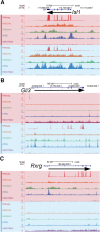

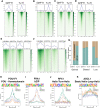
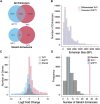
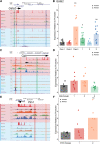
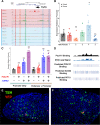
Similar articles
-
Transcriptional regulation of the chicken CRHR2 gene by pituitary transcription factors.Gen Comp Endocrinol. 2019 Dec 1;284:113263. doi: 10.1016/j.ygcen.2019.113263. Epub 2019 Aug 24. Gen Comp Endocrinol. 2019. PMID: 31454497
-
Thyrotropin-releasing hormone regulation of human TSHB expression: role of a pituitary-specific transcription factor (Pit-1/GHF-1) and potential interaction with a thyroid hormone-inhibitory element.Proc Natl Acad Sci U S A. 1991 Apr 15;88(8):3130-4. doi: 10.1073/pnas.88.8.3130. Proc Natl Acad Sci U S A. 1991. PMID: 1901656 Free PMC article.
-
The thyrotrope-restricted isoform of the retinoid-X receptor-gamma1 mediates 9-cis-retinoic acid suppression of thyrotropin-beta promoter activity.Mol Endocrinol. 1997 Apr;11(4):481-9. doi: 10.1210/mend.11.4.9905. Mol Endocrinol. 1997. PMID: 9092800
-
Transcription factors in normal and neoplastic pituitary tissues.Microsc Res Tech. 1997 Oct 15;39(2):168-81. doi: 10.1002/(SICI)1097-0029(19971015)39:2<168::AID-JEMT8>3.0.CO;2-H. Microsc Res Tech. 1997. PMID: 9361268 Review.
-
[Progress on pituitary-specific transcription factor (POU1F1) in poultry].Yi Chuan. 2004 Nov;26(6):957-61. Yi Chuan. 2004. PMID: 15640133 Review. Chinese.
Cited by
-
Duplications disrupt chromatin architecture and rewire GPR101-enhancer communication in X-linked acrogigantism.Am J Hum Genet. 2022 Apr 7;109(4):553-570. doi: 10.1016/j.ajhg.2022.02.002. Epub 2022 Feb 23. Am J Hum Genet. 2022. PMID: 35202564 Free PMC article.
-
Transcriptomic Profiles of Normal Pituitary Cells and Pituitary Neuroendocrine Tumor Cells.Cancers (Basel). 2022 Dec 24;15(1):110. doi: 10.3390/cancers15010110. Cancers (Basel). 2022. PMID: 36612109 Free PMC article. Review.
-
Co-profiling of single-cell gene expression and chromatin landscapes in stickleback pituitary.Sci Data. 2025 Jan 10;12(1):41. doi: 10.1038/s41597-025-04376-3. Sci Data. 2025. PMID: 39789025 Free PMC article.
-
Pituitary stem cells: past, present and future perspectives.Nat Rev Endocrinol. 2024 Feb;20(2):77-92. doi: 10.1038/s41574-023-00922-4. Epub 2023 Dec 15. Nat Rev Endocrinol. 2024. PMID: 38102391 Free PMC article. Review.
References
-
- Jarvis JP, Scheinfeldt LB, Soi S, Lambert C, Omberg L, Ferwerda B, Froment A, Bodo JM, Beggs W, Hoffman G, Mezey J, Tishkoff SA. Patterns of ancestry, signatures of natural selection, and genetic association with stature in Western African pygmies. PLoS Genet. 2012;8(4):e1002641. doi: 10.1371/journal.pgen.1002641. - DOI - PMC - PubMed
-
- Ye Z, Li Z, Wang Y, Mao Y, Shen M, Zhang Q, Li S, Zhou L, Shou X, Chen J, Song Z, Ma Z, Zhang Z, Li Y, Ye H, Huang C, Wang T, He W, Zhang Y, Xie R, Qiao N, Qiu H, Huang S, Wang M, Shen J, Wen Z, Li W, Liu K, Zhou J, Wang L, Ji J, Wang Y, Chen H, Cheng H, Shi Z, Zhu Y, Geng D, Yao Z, Tang W, Lu B, Pan L, Zhang Y, Bao W, Wu J, Zheng K, Shi Y, Zhao Y. Common variants at 10p12.31, 10q21.1 and 13q12.13 are associated with sporadic pituitary adenoma. Nat Genet. 2015;47(7):793–797. doi: 10.1038/ng.3322. - DOI - PubMed
Publication types
MeSH terms
Substances
Grants and funding
LinkOut - more resources
Full Text Sources
Other Literature Sources
Research Materials
Miscellaneous

